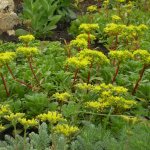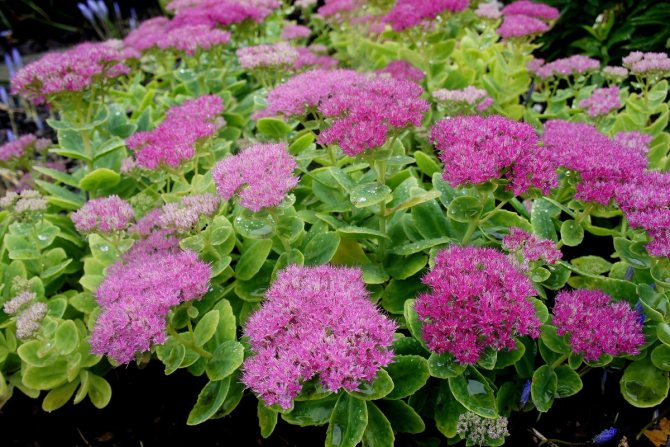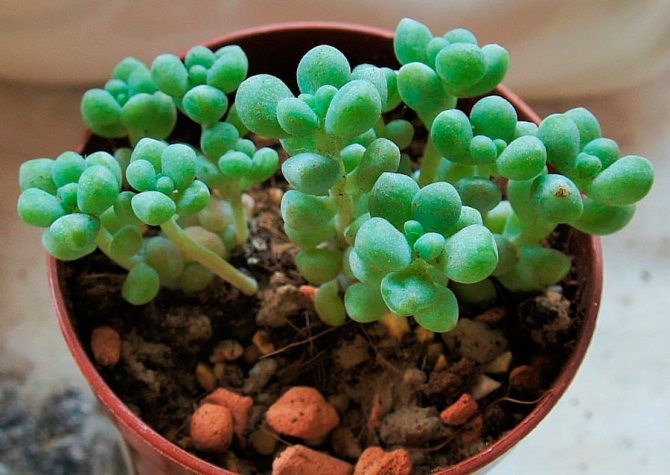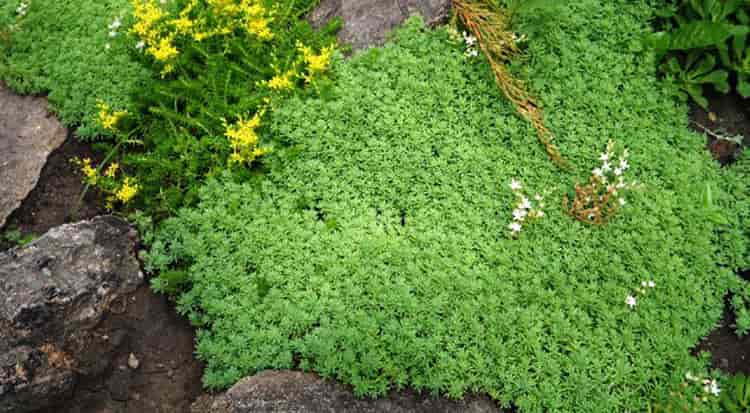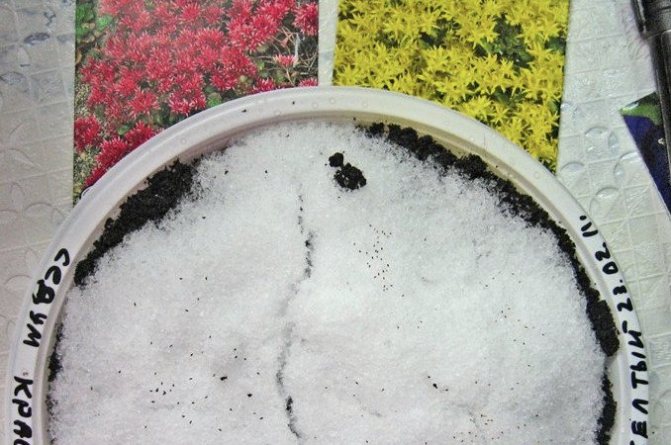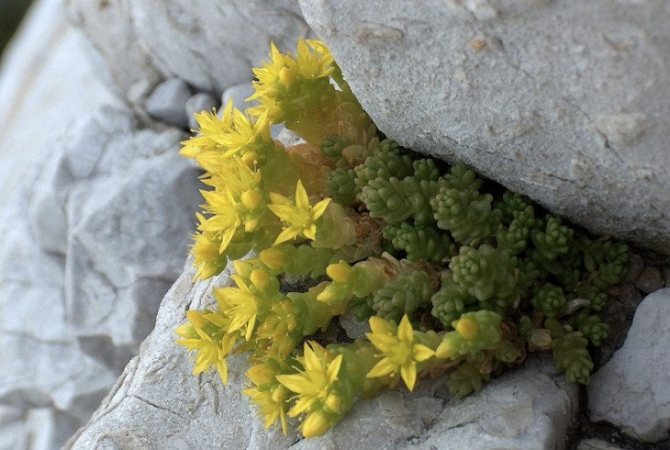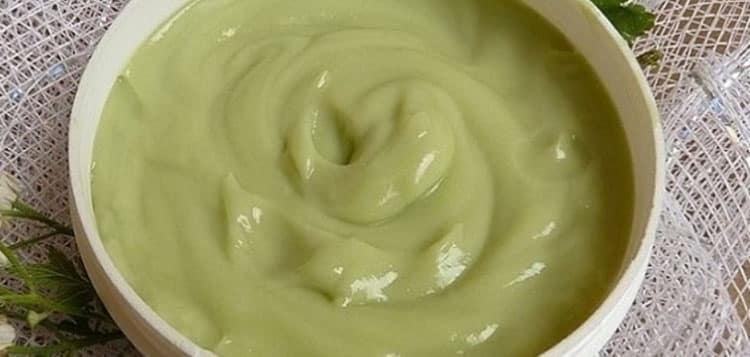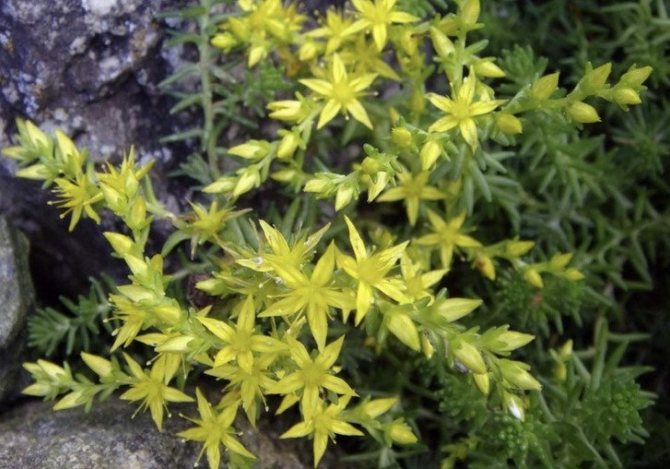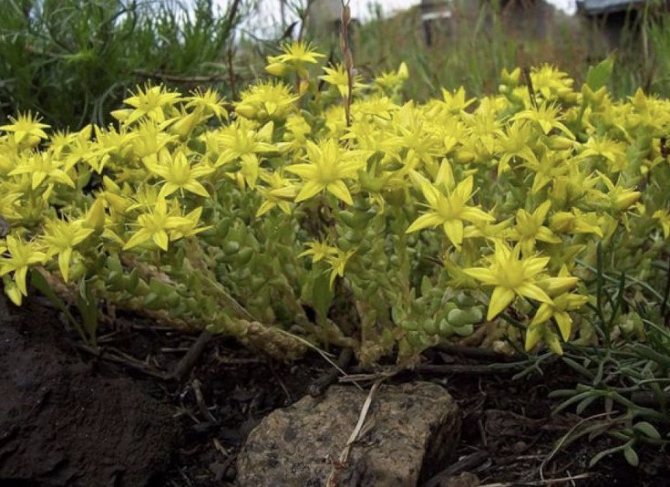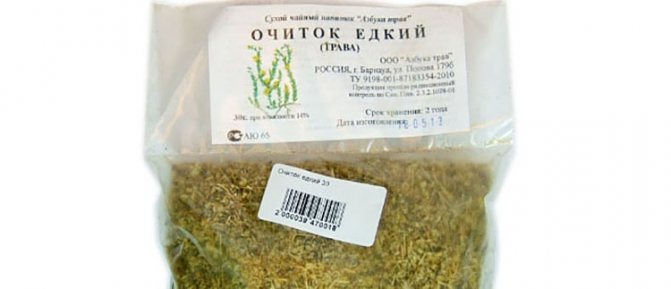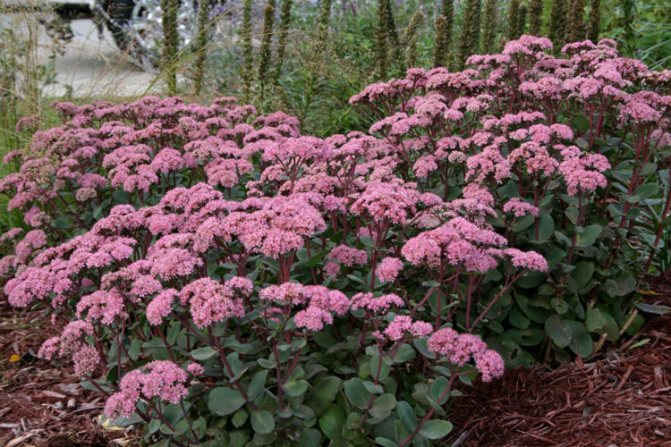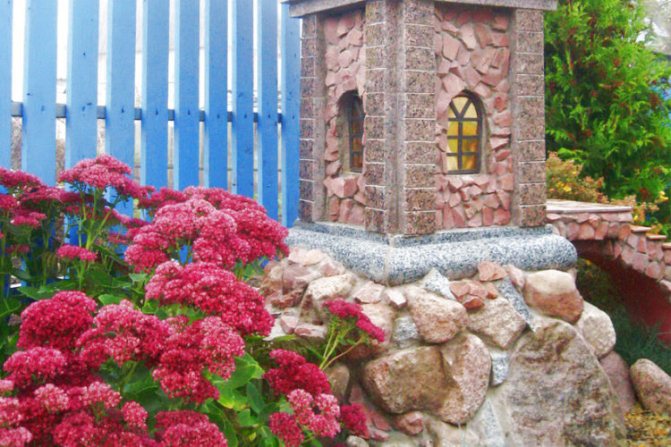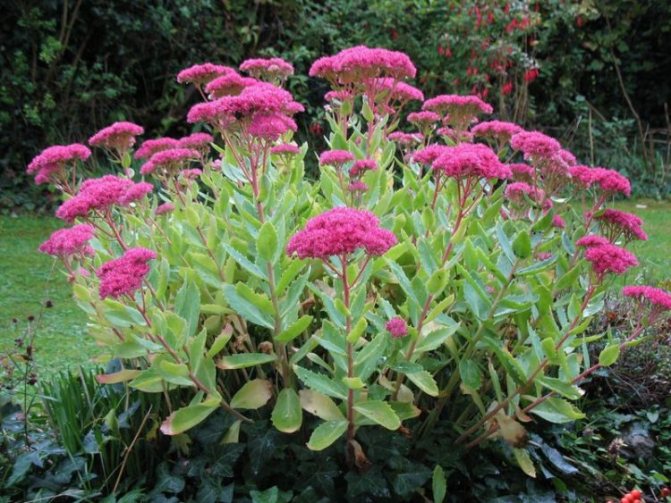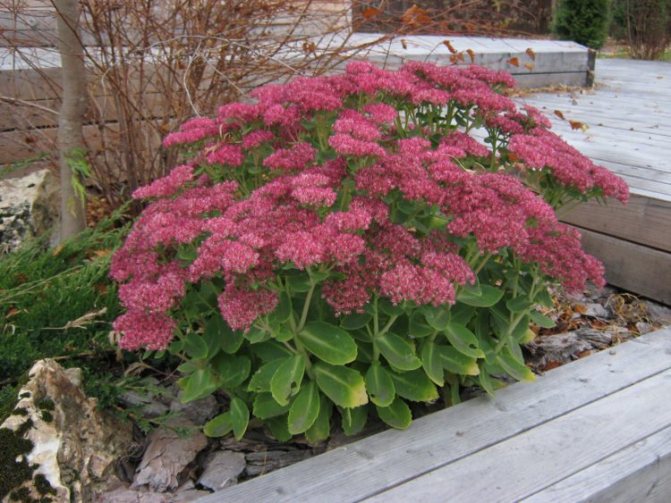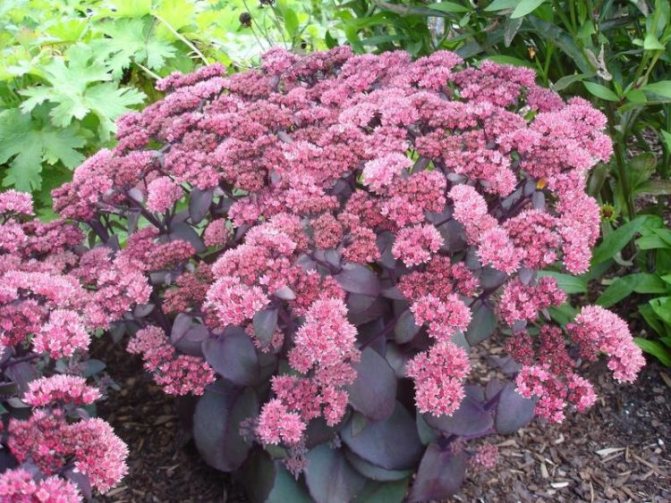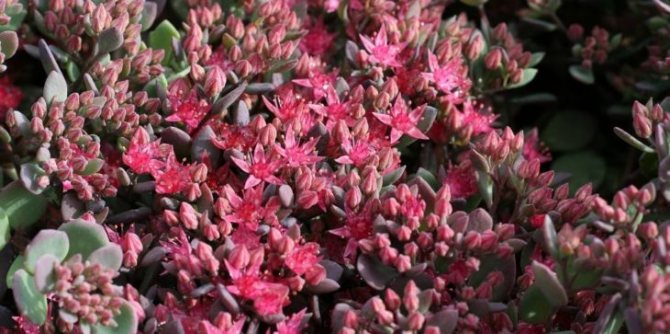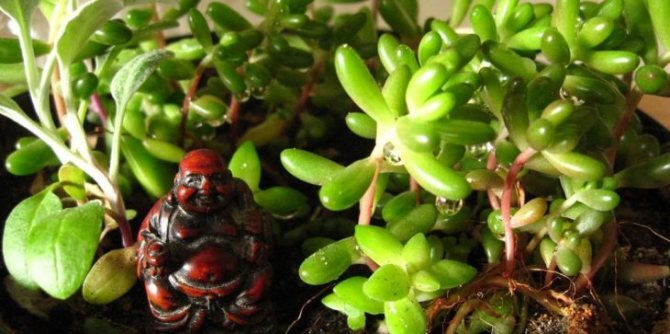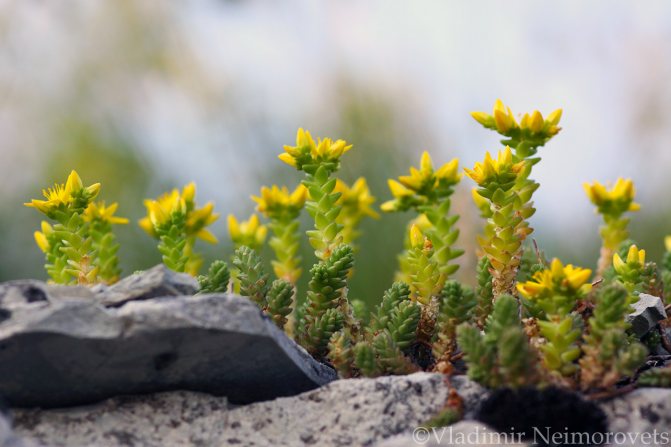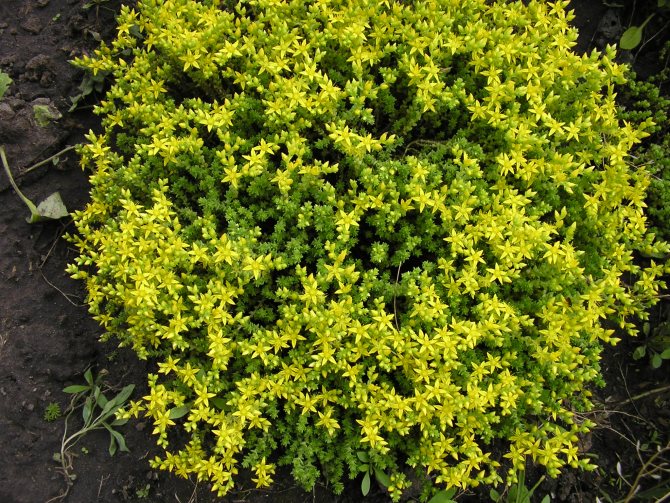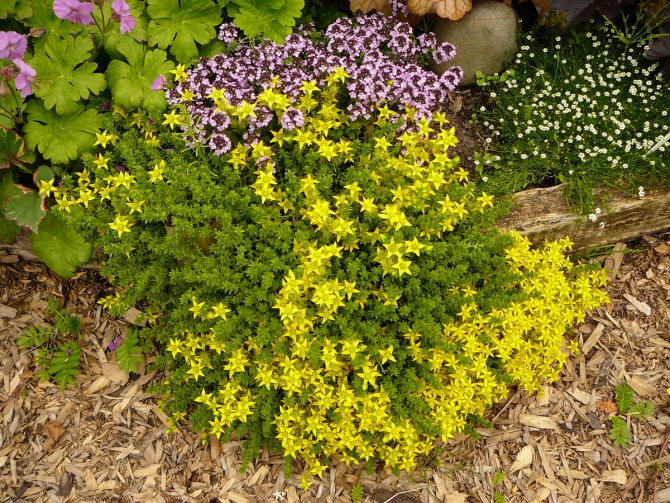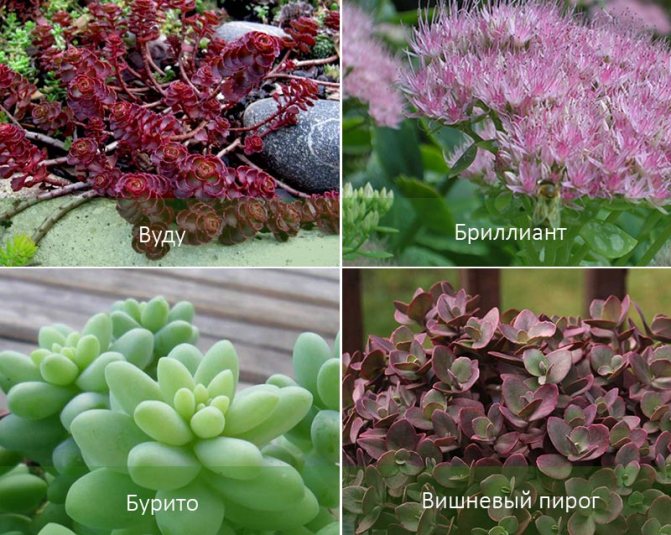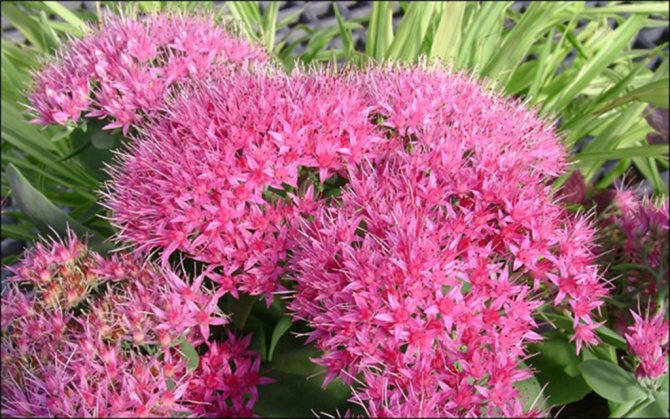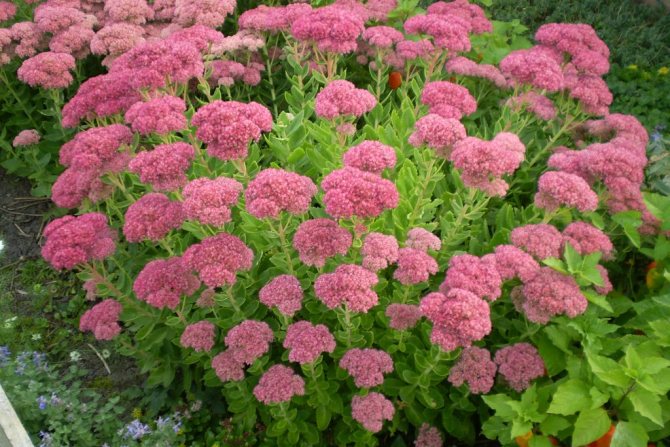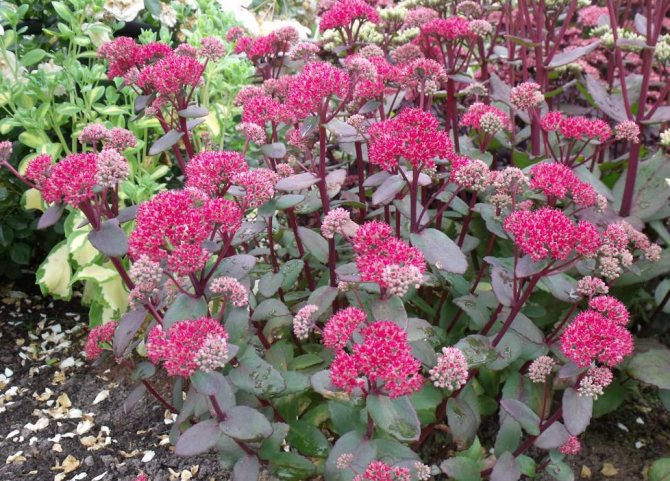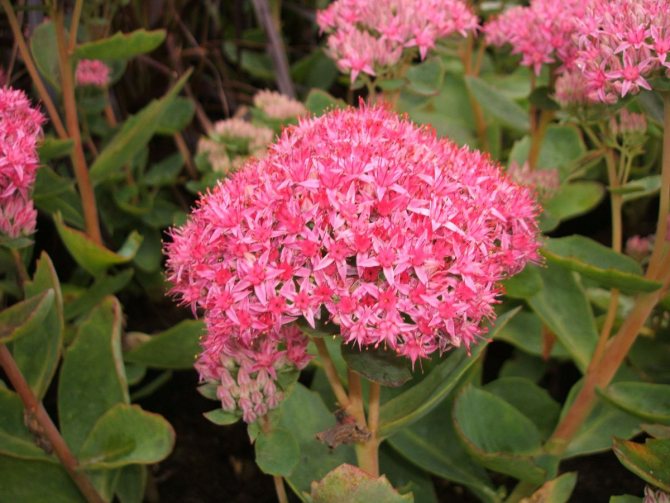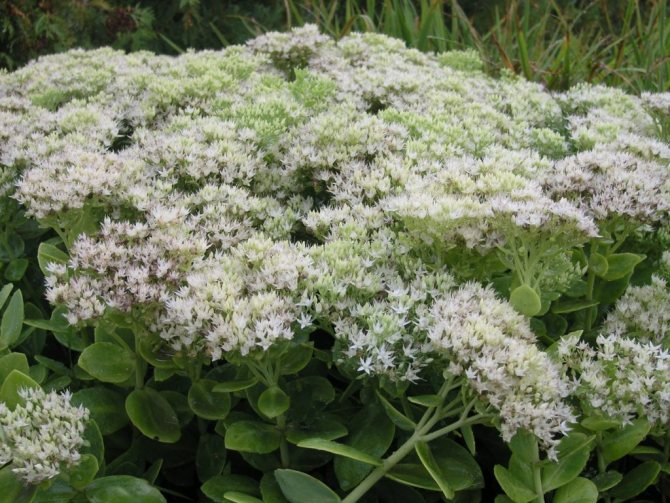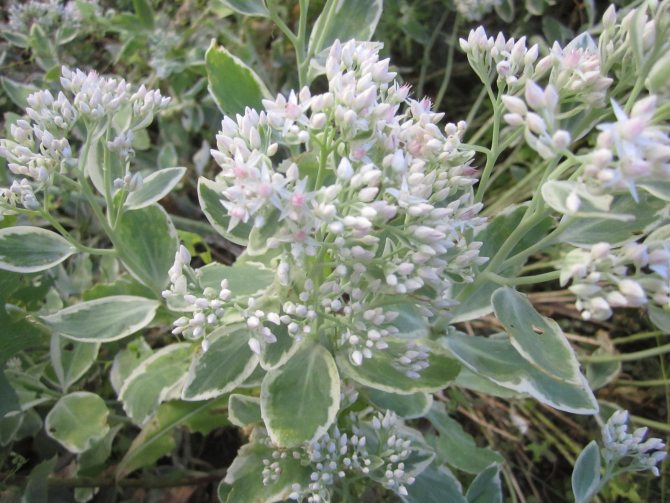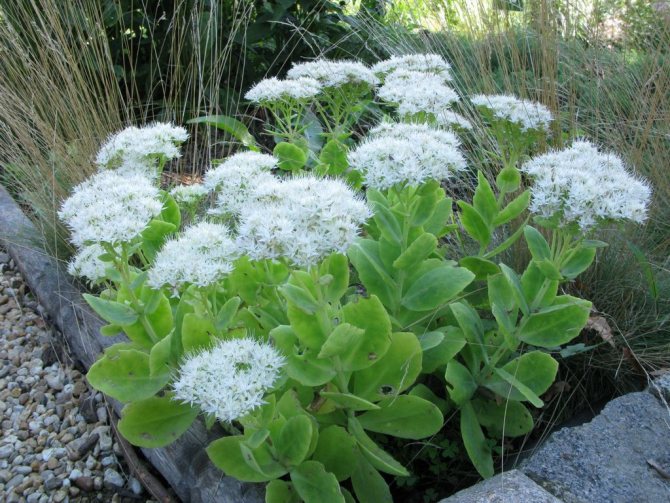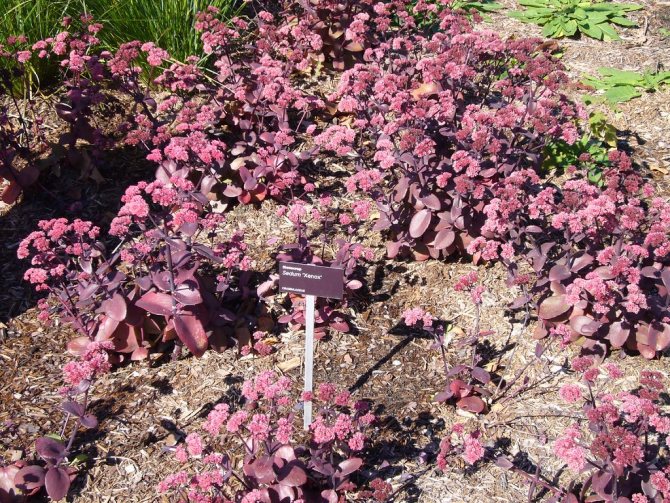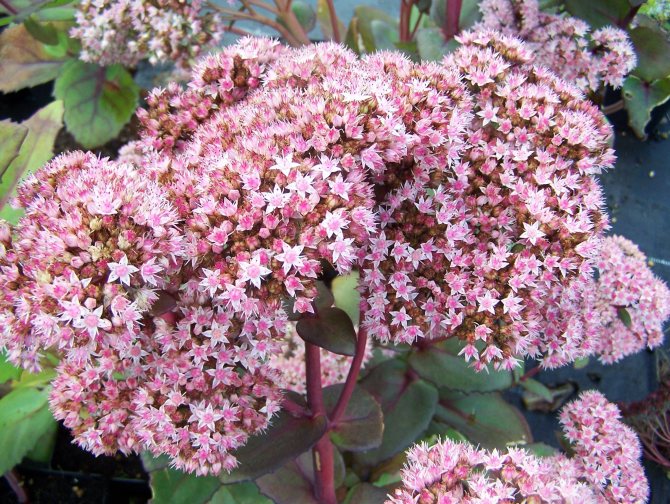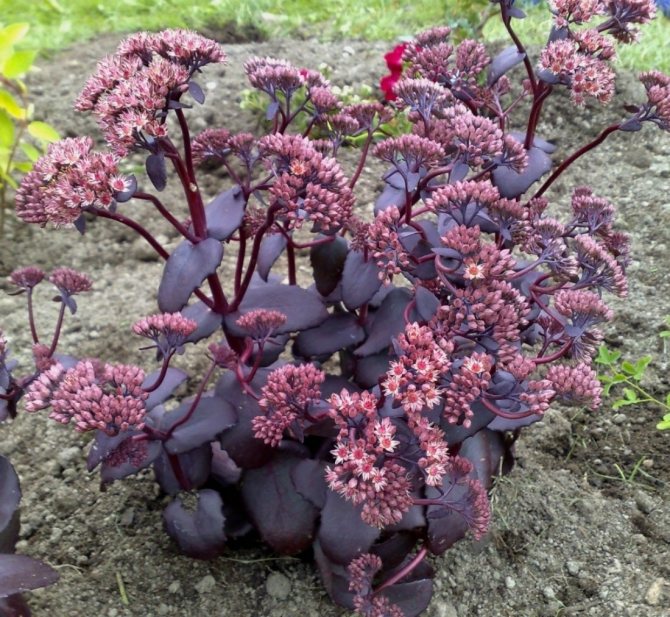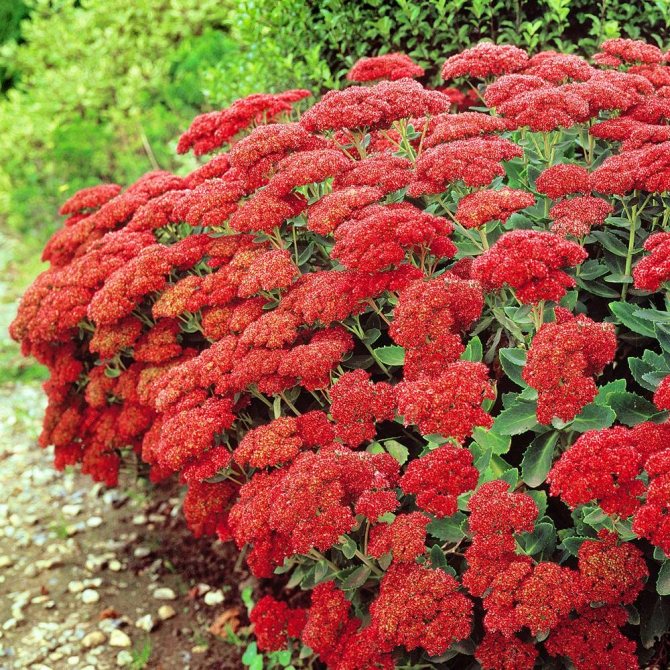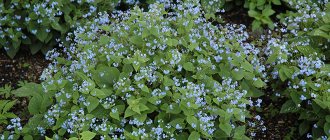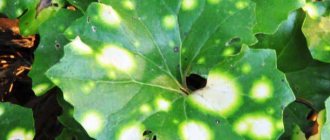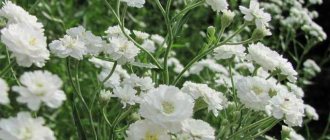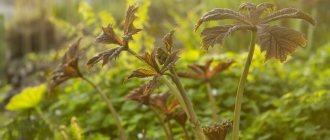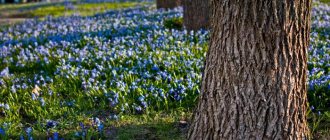Stonecrop care
Sedum, sedum, or hare cabbage is a herbaceous plant that belongs to the jungle family. The homeland of this decorative beauty is Korea, Japan and China.
The Tolstyanka family is very numerous and unites more than five hundred varieties and types of stonecrops, different in shape, size, color of inflorescences. In addition, sedum is a garden plant, which is represented by both annuals and perennials.
Plant appearance
Despite the fact that the vast majority of sedum plants are succulents, different varieties differ in size. Ground cover species, undersized, tall and even half-shrubs grow in the gardens.
Hare cabbage is compact in size, reminiscent of a lush bush. The root system of a plant can be stem-shaped or tuber-shaped. The length of the roots reaches 70 centimeters. Each plant has one or more stems that lack branches. The leaves of the plant are fleshy, large, flat and oval in shape. The arrangement of leaves on the stem is alternate.
The corymbose inflorescence, consisting of small flowers, is located in the upper part of the stem. Each flower has five petals, five pistils and ten stamens. Inflorescences come in various shades.
Watering the plant
In the case of stonecrop, the main thing is to observe the rule: it is better to underfill a little water than to pour it over. During the period of active growth, the soil should dry out by half between waterings. In the fall, watering is reduced.
Illumination requirements
The plant is quite demanding on light, in the shade the leaves become pale, the stems are too long, and the inflorescences lose their decorative effect. This is why choose a well-lit place in your garden for sedum and don't be afraid of direct sunlight.
Temperature regime
Sedum thrives and develops at different temperatures. He is not afraid of hot summer days and cold winters.
Fertilization and feeding
It is best to use liquid mineral and organic fertilizers. Fertilizers containing nitrogen and manure are acceptable. However, the excess content of nutrients in the soil can negatively affect the plant's ability to withstand low temperatures, and the decorative effect of sedum is also reduced.
Soil requirements
For the vast majority of sedums, the composition of the soil does not really matter. They can even be grown on rocks and are great for rockeries and alpine slides.
Stonecrop also feels good on sandy soils and limestones.
Additional care
Sedum grows poorly in weedy areas, so you will need to weed regularly to grow this plant successfully.
Medicinal properties and contraindications
The plant has a wide range of applications. If you know the properties of stonecrop, then you can fight many ailments. The healing qualities of the plant:
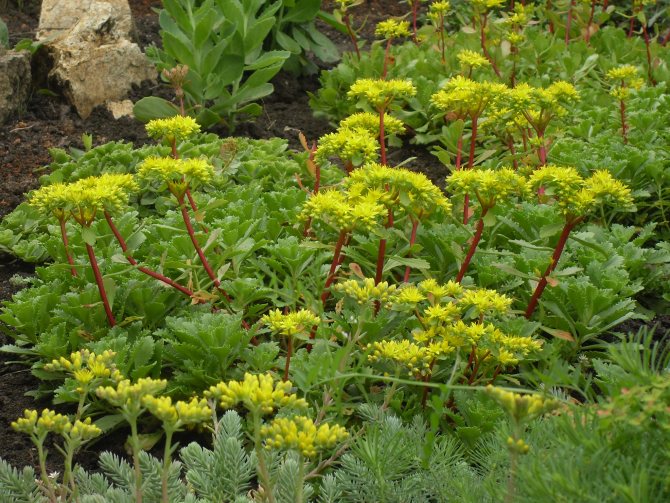
Hemostatic and analgesic, relieves inflammation and heals wounds;- Strengthens the nervous system;
- Tannins strengthen the walls of blood vessels, reducing the formation of blood clots, lowering the pressure;
- In case of colds, it has a beneficial effect on the upper respiratory tract, promoting the discharge of phlegm and destroying pathogenic microbes;
- Improves the functioning of the gastrointestinal tract, stimulates bile formation with the help of flavonoids;
- Improves metabolism, helps to stabilize weight, removes toxins;
- Coumarins in the plant inhibit and suppress cancer cells, stopping metastases.
The use of stonecrop is very extensive. Infusions and lotions treat wounds and inflammations on the skin. The oil mixture is used for eczema and neurodermatitis, lichen. Pounded leaves eliminate boils and abscesses, relieve joint pain. Periodontal disease, stomatitis and inflammation of the gums can be eliminated by rinsing the mouth with infusion or decoction of stonecrop.
It is used to treat and prevent diseases of the gallbladder, adrenal glands, and liver. Sedum cleans the body of parasites, helps to alleviate cough in tuberculosis, bronchitis, relieves itching and swelling with insect bites.
Official medicine uses raw materials in the treatment of eyes: burns of the mucous membrane of the eye, corneal opacity. The plant is used in surgery for bone tissue fusion, trophic ulcers of the leg. In cardiology, sedum is used to increase the tone of the heart muscle, stimulate the heart. The sedum is found in many biostimulants. He successfully fights freckles, papillomas, warts in cosmetology. You can wipe freckles with the juice of the flowers of the plant, after a while they become less noticeable.
In addition to medicinal properties, stonecrop has contraindications... It is harmful to children, pregnant women, breastfeeding mothers. Excessive use can cause vomiting, dizziness, and general malaise. The plant extract should be taken internally with discretion and preferably under the supervision of a competent specialist.
Plant composition
Nature has invested many useful substances in sedum, its medicinal properties are extensive. Tannins help relieve inflammation, heal wounds faster, normalize the work of the gastrointestinal tract, remove unwanted actions of microbes and bacteria.
Ascorbic acid removes toxins, enhances the absorption of iron, improves the functioning of the central nervous system, and raises immunity.
Glycosides help vasodilation, sputum discharge, and enhance the diuretic effect. Alkaloids lower blood pressure, act as a pain reliever. Carbohydrates energize the entire body.
Organic acids lower blood cholesterol, have a beneficial effect on the intestines, normalize metabolism, renew joint mobility, stimulate insulin production, have a beneficial effect on blood vessels, and increase reproductive activity.
Flavonoids stimulate adrenal function, normalize heart rate, promote bile formation, and reduce vascular permeability.
Saponins prevent plaque formation, remove phlegm, act as a diuretic, and heal wounds and ulcers. Coumarins stop the development of tumors, preventing metastases from growing.
Applications
The composition and healing properties of the stonecrop flower determine its beneficial effect on the body. It can be used for a variety of medicinal purposes: it is a healing, antineoplastic, analgesic, laxative, diuretic, tonic, anti-inflammatory, hemostatic agent.
Fresh herb harvested in dry weather is considered a healing material. It is harvested during the flowering of stonecrop. The grass must be cut and dried under a canopy. Poorly dried grass continues to grow, reducing its medicinal properties. To prevent growth, the plant should be pre-crushed, scalded with boiling water, dried in the sun or dried in an oven or in a dryer at 60-80 degrees.
The harvested grass has an almost imperceptible smell and can be stored for up to two years. The roots can be used for up to three years.In folk medicine, sedum is widely used for a number of diseases: scurvy, burns, malaria, constipation, gout, atherosclerosis, female diseases, epilepsy, arthritis, jaundice.
Decoctions are prepared from crushed leaves - 3 tablespoons are poured into 400 ml of water, heated over a fire, boiled for 3-4 minutes and allowed to brew for about an hour. Take 150 ml three times a day. The infusion is recommended for stomach cancer.
Stonecrop extract acts as a biostimulant and is prepared in two stages. First you need to prepare an infusion: put the leaves in an enamel pan, pour boiling water in a ratio of 1:10 for internal use or 1:15 for external use. Then leave in a water bath for 10-20 minutes. Then strain the infusion and evaporate half. Store in a cool place, take 15-20 drops three to four times a day. The extract heals skin diseases: purulent wounds, rashes, ulcers.
You can prepare an ointment. To do this, mix fresh grass juice with warm butter 1: 1. Juice can be replaced with chopped raw materials.
The use of herbs as prevention and health support will not harm, but competent medical advice is important if you decide to cure the disease with only folk remedies.
Stonecrop transplant
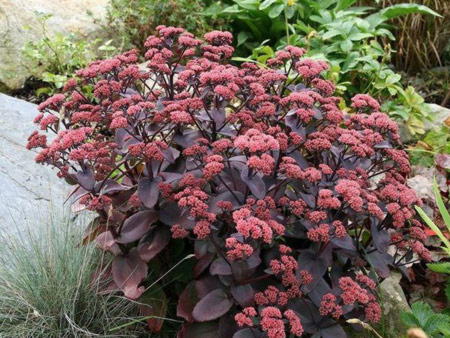

Gardeners do not advise disturbing the plant unnecessarily.
It is necessary to transplant sedum in the following situations:
- Shrub rejuvenation;
- Forced measure when the plant is sick;
- When a plant propagates by division.
When transplanting, it is important to provide a good drainage layer in the planting pit, which will ensure the outflow of excess water from the root system.
Experts recommend rejuvenating stonecrop every five to seven years.
Photo
Sedum acre caustic: Sedum caustic:
Stonecrop propagation
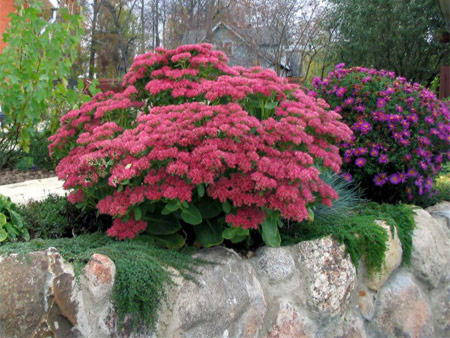

There are several types of stonecrop breeding:
- Cuttings;
- By dividing the bush;
- Seeds.
Cuttings
This method is the safest for the plant and the easiest for the grower. To do this, you will need to cut off the upper parts of the shoots and scatter them on the prepared area, sprinkle with earth with a layer of one centimeter, lightly compact and water until the young plants gain strength.
Winter grafting is a sedum propagation method that is used in the fall. At the end of the flowering period, it is necessary to cut the cuttings on the flowering shoots and keep them in a dry room for several months. During this time, young shoots with roots are formed in the leaf axils.
New plants are planted after the length of the root system exceeds five centimeters. For planting, use wooden boxes filled with a substrate with the addition of sand.
Dividing the bush
Plants that are less than four years old are suitable for this propagation method. Older sedum bushes are very difficult to separate.
It is necessary to choose a period for dividing a plant, taking into account the characteristics of a particular variety, namely, the period of flowering of stonecrop.
Seed propagation
This method is laborious and consists in planting sedum seeds in boxes in the spring, then the seedlings must be dived, and after rooting of young plants they are planted in open ground. The first inflorescences form on the plant after two or three years.
When and how often can you replant?
Gradually, stonecrop bushes age and degenerate, so a transplant is performed for rejuvenation. For young stonecrops, it is done once every two years, but adult plants are transplanted once every four to five years.
Attention! The transplant is made necessarily to a new place, while it must be prepared in the same way as for a regular planting, that is, add fertilizers, sand and wood ash.
It is recommended to do the procedure in the spring, but in autumn it is also possible, immediately after flowering.It is often not worth replanting, it is necessary only when the plant is sick, has grown strongly, or it is time to rejuvenate it.
Stonecrop flowering
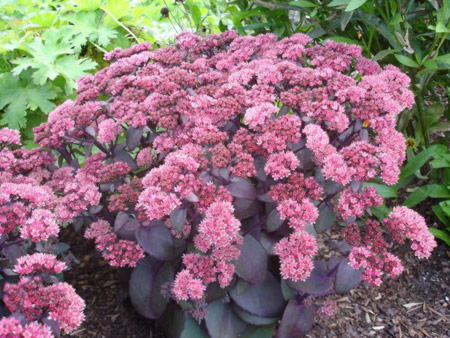

The attractiveness and decorativeness of stonecrop is fully manifested during the flowering period, which begins in July and lasts until frost. During this period, small flowers bloom on the bushes, collected in inflorescences, of different shades: white, pink, purple, lilac. The diameter of one inflorescence can reach 20 centimeters. A plant with such large and decorative flowers will certainly become a decoration of any garden and will be noticeable in any corner of the site.
After flowering, fruits with seeds ripen on the plant. Typically, one flower leaves five fruits, each of which is a pink or red leaf filled with brown seeds.
Hare cabbage inflorescences are pollinated by bees. The peculiarity of this honey plant is that sedum flowers secrete nectar even in the hottest weather, unlike other melliferous plants.
How to plant sedum: step by step instructions
To the site
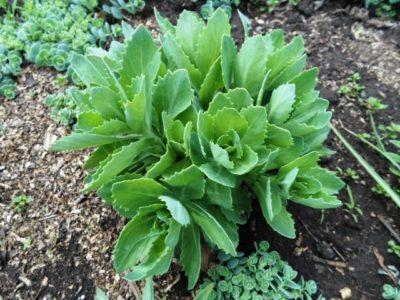

First you need to find a sunny spot.- Next, we prepare the soil. You need to take sand and humus in a 3: 1 ratio and mix thoroughly.
- Then we dig a hole 15-20 centimeters deep and 50 centimeters wide.
- Now the hole is filled with prepared soil.
- A flower is carefully planted in it.
- Around the seedling, the soil is sprinkled with gravel or fine gravel.
- If everything was done correctly, sedum will delight you with excellent growth and excellent flowering.
In a pot or container
- The first step is to choose the right type and variety.
- Then you need to choose the correct size container. The best option is a shallow and wide pot.
- Next, the soil mixture is mixed, which must be poured into a pot.
- After that, the flower is planted.
- Planting in protected ground can be done throughout the year, but subject to a positive indoor temperature.
- During the spring transplant, sedum will take root better and grow faster.
Sedum pruning
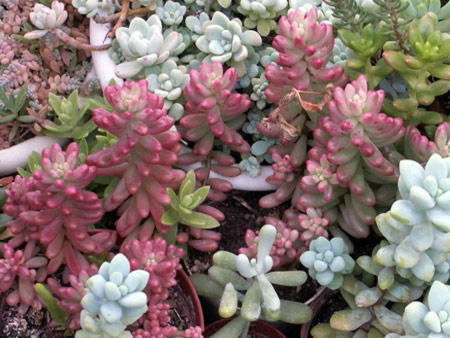

Pruning the plant is only necessary if you want sedum to form a lush green carpet on your site. In this case, old shoots are cut off from old plants, which are more than three years old, and the soil is enriched with mineral and organic fertilizers. If necessary, you can add earth.
In addition, twigs and inflorescences protruding above the carpet should be cut off.
If your sedum grows in a rock garden, add fine gravel to it for greater comfort.
Description
Sedum caustic description - type species of the genus Sedum. Most of the features inherent in other members of the genus are characteristic of him.
This is a herbaceous plant no more than 15 cm high has many stems, fleshy ovoid leaves, spreading inflorescences of yellow flowers.
In nature, stonecrop, as a rule, grows in company - numerous plants form low, but dense bushes.
Hare cabbage rhizome - thick and powerful... With its help, the plant can receive all the moisture it needs only from the soil, and thus grow and bloom in the most arid and infertile places.
Diseases and pests
Although sedum is quite resistant to disease and pests, some varieties can suffer from insects such as weevil, thrips, aphids, and sawfly.
- Sawfly
Caterpillars appear on the plant in July. You can fight pests with the help of chemicals, or using a bait from a cabbage leaf, which is placed under the stonecrop and covered with a board. After a while, all the insects end up on a tasty treat and can be easily destroyed.
- Aphid
To combat these pests, it is better to use special chemicals.Many gardeners also recommend using them for processing black currants. They are good because they do not burn leaves and flowers.
- Thrips
It appears on hare cabbage quite rarely and leads to curvature of the tops of the plants. To combat the pest, chemicals purchased in specialized stores are used.
- Weevils
Young leaves, which are the main diet for insects, are most affected by insects. Adults feed at night, and the larvae feast on leaves at any time. To get rid of pests, gardeners recommend picking them by hand. To do this, take a white sheet of paper and shake off the insects.
- Fungal infections
Cold air and excessive dampness are the reason for the appearance. Infections appear in the form of dark spots on leaf plates and stems. If you find signs of fungus on the stonecrop, immediately cut off the affected areas of the plant and burn them.
Growing at home
Sedum caustic is an unpretentious plant, the care of which does not require special skills. However, if certain rules are followed, the plant will have a healthy and attractive appearance.
Choosing a landing site
This herbaceous shrub needs good lighting, therefore, when choosing a place to plant it, pay attention to sunny areas in the garden. It is also possible to grow it in the shade of trees, but you will hardly expect a fragrant flowering from the plant.
Soil and fertilizer
Stonecrop has very ascetic requirements for the conditions of its maintenance, the composition of the soil is no exception. The "simpler" the composition of the soil mixture, the better it will grow and bloom. Choose a loose soil with a lot of clay and sand, add a little humus and ash to the mixture, and the ideal soil for the growth and flowering of this type of plant is ready.
There is no need for additional feeding. If you decide to apply phosphorus-potassium fertilizers, then choose the smallest concentration of them. Fertilizers containing nitrogen have a double effect on sedum - they accelerate its growth, but at the same time significantly reduce the plant's resistance to diseases.
Did you know? Stonecrop can be used not only in medicine. Delicious and healthy honey is obtained from this plant.
Watering and moisture
Stonecrop growing in the garden in the open air rarely needs watering - it takes the necessary moisture from the soil on its own. Additional moisture is possible during particularly dry weeks of summer. He also does not need air humidity and spraying for comfortable growth - a plant growing in nature chooses areas with dried soil, so excess moisture will rather harm than benefit.
Reproduction
The propagation of stonecrop is possible in two ways - by seeds and vegetatively. Both methods do not require special skills; we propose to consider each of them in more detail.
Seeds
Propagation of caustic stonecrop by seeds is a fairly easy process. The seeds are sown in mid-March. A prerequisite for the successful reproduction of sedum in this way is the preliminary stratification of seeds. To do this, you will need to place the seed in the ground, cover the container with glass or plastic wrap and place it in the refrigerator. The temperature should not be lower than +5 ° С, in modern refrigerators this temperature regime is observed in the compartments for storing vegetables and fresh herbs. The stratification period is two weeks.
Once a day, you need to open the film for a short time for airing, and if the soil dries out, moisten it from a spray bottle. After such preparation, the seeds are ready for germination - the container with the seeds is opened and placed in a well-lit place, with a temperature of at least +18 ° C. If all conditions are met, the first shoots should appear in 15-25 days.
Note to the gardener
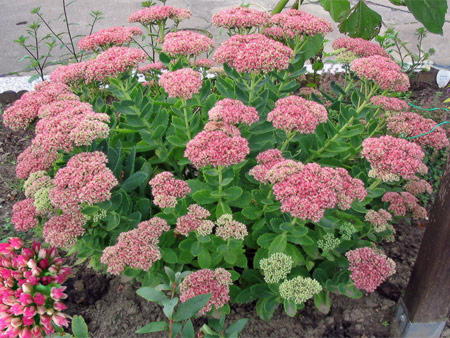

- Exposure of the stem
The main cause of the problem is not enough light. It is necessary to choose a well-lit area for the plant with direct sunlight and transplant sedum in order to return the decorative look to the bush.
- Decay of roots
As a rule, the root system begins to rot after abundant and frequent watering. First of all, you should reduce watering. If this does not help, you will need to update the plant by cuttings.
- Leaves wither
The cause of the problem is a lack of moisture. It is enough just to water the plant and prevent the earthen coma from drying out too much.
Growing reviews
I will sow three types of my sedum seeds directly into the ground in mid-May. I have already concluded that the seeds grow very well this way.
this stonecrop has very small roots and itself is not high. If shrubs grow on your flower beds, as you wrote, then sedum will not be able to harm them - they are much larger than it and have more developed roots. Unless planting it to the rhododendrons raises doubts - after all, rhododendrons need regular watering, and sedum is dry-loving and with frequent watering can "fatten" - grow very quickly and vomit in depth. Although you can try. After flowering, the flowering shoots dry up, and if such a view will irritate, it would have to be "pulled through", removing the dried up. So in large areas it can get quite labor intensive.
Recently, gardeners have increasingly begun to grow succulents in their garden plots. There are several reasons for this. Firstly, caring for such plants is not difficult, and secondly, they give the site an uniqueness, originality. One of these popular succulent plants is sedum or sedum. Today, a large number of species of this plant are known - about 600, with a third of them being cultivated forms. All varieties are divided into thermophilic tropical, which are grown in our latitudes as indoor plants, and winter-hardy, ground cover.
Stonecrop care video
Sedum or hare cabbage has been grown in gardens for many years. This plant is loved by gardeners for its unpretentious disposition. The main thing to remember when growing sedum is that you need good lighting, an area with direct sunlight, and infrequent and abundant watering. At the same time, the plant is completely undemanding to the composition of the soil, grows well on sandstones and stones and does not require additional insulation for the winter.
You can also share your secrets of stonecrop care. If you have any questions - ask them in the comments below, we will be happy to answer them.
The composition of the potting mix
The sedum is not at all whimsical to the ground... The flower grows easily in poor soil. It can grow on sandy, limestone and even heavy acidic soils. Loves well-permeable earth. Acidic, alkaline and neutral soils are suitable Ph. The plant is adapted to wet and dry lands. Feels good in a maritime climate.
The soil composition depends on the type of sedum, for example, creeping varieties prefer dry and poor soil, but tall and profusely blooming ones will need more nutritious and loamy soil.
Room
Description
Fleshy beautiful leaves, small but attractive inflorescences, resistance to drought, overheating and other unpleasant moments of existence in a city apartment made sedum a fairly popular inhabitant of houses and rooms.
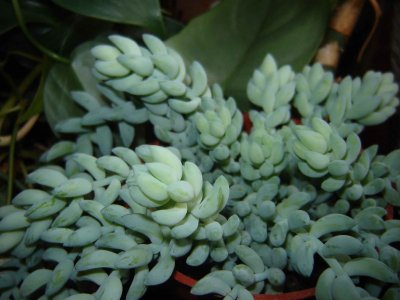

Most often, the stonecrop of Morgan is found as a potted interior decoration - it is popularly called indoor grape - the plant is very interesting, its leaves are shaped like grapes, sit tightly on the stem, the stem droops under their weight, and it is usually suspended.
How convenient to have on hand the medicine that grew on your windowsill, and you can use it as needed!
It is possible to use the soft juicy pulp that fills the thick leaves of stonecrop in the same cases as the pulp and juice of aloe, in terms of their qualities, medicinal stonecrops are not inferior.
Pungent
Description
Sedum caustic - a miniature ground cover plant, often leaving in winter under the snow with live shoots and leaves.
The rhizome is branched, numerous stems are more than 15 centimeters, they do not rise above the soil surface, the leaf is small, sessile, thick, bright yellow flowers have the shape of a five-pointed star, collected in loose inflorescences.
Application
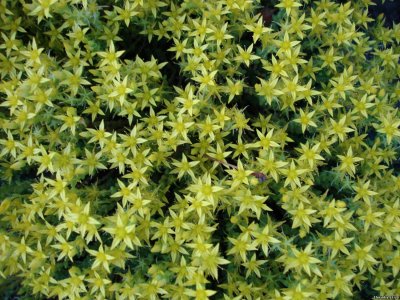

Traditional healers knew - sedum must be used with caution, it is poisonous.
The juice was used to remove warts, calluses, if it gets on the skin, it could cause a burn.
Infusions and decoctions of medicinal stonecrop caustic have a strong diuretic, anti-inflammatory, restorative effect, have been successfully treated with caustic stonecrop malaria, epilepsy, atherosclerosis /
Side effects
This the type of sedum cannot be used to treat children, pregnant and lactating mothers, when using it, nausea, vomiting, intestinal cramps, difficulty breathing are possible.
The chemical composition of caustic stonecrop is well studied; it includes alkaloids, glycosides, saponins, organic acids, resins, vitamins.
Collection and procurement of raw materials
For the use of stonecrop in folk medicine, the flowering grass of the plant is collected. Shoots are cut off, retreating a few centimeters from the soil. After that, the cut parts of the plant are sorted out for impurities and damaged areas, immersed in boiling water for a minute.
Lay out in the air with mandatory shading so that the remaining moisture evaporates. Before final drying, the grass is crushed. Dried under a canopy, spread out in a thin layer on a porous tray. After the grass has dried, it is packed in fabric or plastic bags. Store in a dark, ventilated place for two years.
Sedum purple is collected in the flowering phase (grass), as well as in late autumn (rhizome). When preparing it, the following rules are observed:
- sedum purple (roots) is dried - washed and crushed;
- parts of the rhizome are laid out - in a thin layer on a pallet under a canopy;
- after complete drying - packed in linen bags.
When collecting sedum, care must be taken to protect the skin from the ingress of plant sap. It is recommended to use high gloves. In the place of contact of the skin with the juice, an inflammatory process occurs, blisters may appear.
Watering
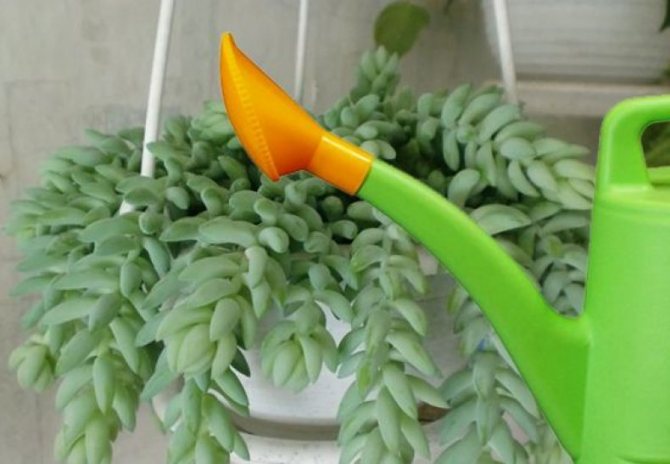

Watering stonecrop should be more than moderate: it is better to underfill than overflow. The sedum stores water in the leaves and evaporates very little. If in doubt whether to water or not, it is best not to water. Even in the hottest summer, the soil in the pot should dry out thoroughly between waterings. For this reason, it is possible to add sedum to other flowers in a pot, but these flowers should not require frequent watering.
Sedum is a very tenacious plant. Facts are known that dried and squeezed between the leaves of a herbarium, sedum remains alive for a long time. Once in favorable conditions, it begins to grow again. Therefore, watering poorly dried soil in a pot is simply unacceptable.
In winter, soil moisture is reduced by half. But, no matter how little sedum needs watering, do not forget that this is not a desert cactus. Water at least once a week in summer and half as often in winter. And never let the water stagnate in the sump. This most often leads to the death of the plant.
It may be interesting: Sansevieria (Sansevieria) - unpretentious perfection
Sometimes sedum grows, covering the entire pot with a green linen, which makes it difficult to get to the ground when watering. Don't be fooled by those who advise pouring it through a sump or by submersion. Often, these methods lead to the death of the plant due to waterlogging.Better use a syringe without a needle.
Sedum planting outdoors step by step
The sedum plant is grown on moisture-permeable soil, where it grows magnificently. Before planting, they dig up the earth, add compost or humus. Groundcover requires a fertilized, light, loose soil. Some varieties grow on loamy, sandy, calcareous soils.
Planted in spring, ideally in May.
Step-by-step actions:
- For each specimen, a hole is dug 20 cm deep and 50 cm wide.
- The bottom is covered with drainage (coarse river sand, pebbles).
- On top of the earth, peat, humus 3: 1.
- A depression is made in the middle of the hole, such as the root of a seedling.
- Place the seedling.
- Sprinkle with soil, press down.
- Watering.
- Several pebbles are laid out around, denoting the hole.
The distance between seedlings is 10-15 cm, between rows - 20 cm.
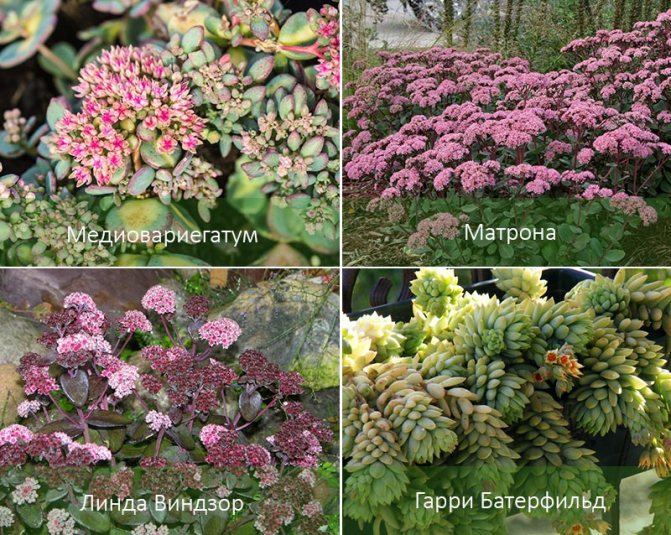

Pharmacological properties of the plant
Sedum in pharmacology is most often used as a biogenic stimulant, since it enhances metabolic processes in the tissues of the body and accelerates regeneration, and also has an anti-inflammatory and tonic effect. It is used for sluggish, poorly healing wounds, with a large loss of blood after severe wounds.
Sedum large is successfully used in the treatment of periodontal disease, and also helps people suffering from chronic inflammation of the sinuses. Preparations based on the roots and herbs of this plant are used to treat purulent cuts and burns, wounds, and accelerate their healing. Similar drugs are also used to treat warts.
- Infusion of roots and leaves;
- Decoction of leaves;
- Leaf juice;
- Infusion of leaves.
Types and varieties of reports with names and photos
There are many varieties of sedum, and about a third of them are domesticated. Cold-resistant varieties and species are grown on a personal plot and in city flower beds. As for the tropical varieties, they have found their place in home floriculture.
Common sedum
It is a medium-sized perennial up to 60 cm high. It has short roots and strong fleshy shoots with the same succulent foliage. Apical inflorescences, multi-flowered, gradually changing color from green to muted pink, and then to purple-burgundy.
Sedum Caustic
A winter-hardy, unpretentious plant that can be found in the wild in Russia. The name "caustic" was given to him for a reason. The sap of plants of this species can corrode the skin to ulcers, therefore, handling it requires special care. Low bushes are densely covered with leaves that do not fall even in cold weather. It blooms with bright yellow small five-leaf buds, forms a dense curtain, painted in calm yellow-green tones.
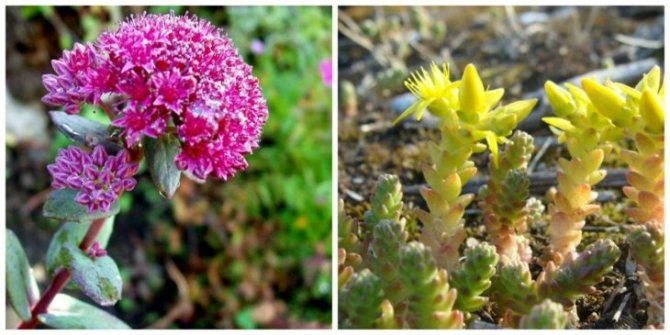

Sedum False
Mountain variety with increased winter hardiness. Shoots of a horizontal ascending type, colored maroon. Intertwining, they create a dense, uneven carpet that blooms in a purple-violet color. Forms inflorescences of the corymbose type.
Sedum Prominent
The homeland of this species is the eastern countries. Bushes of medium height (about half a meter), oppositely sitting leaves, green with a slight bluish tinge. It has many varieties that bloom in purple, violet and lilac tans. On the basis of this variety, many varietal lines have been bred. The most popular are dark-flowered varieties and hybrids, for example, such as "Black Jack" or "Matrona" with what to wear with dark purple shoots, the same color with venation on a green leaf and inflorescences painted in purple tones.
Sedum Lydian
It is a very unpretentious ground cover with gray-green foliage, which can acquire a pink tint when grown in an open sunny area. It blooms with pink buds.


Sedum White
Another groundcover variety that forms a dense covering carpet. When grown on fertile soil, it can behave aggressively, displacing neighboring plants. Star-shaped white-pinkish flowers bloom in large numbers on low peduncles, which the plant actively drives out in the middle of summer. With the onset of the first cold weather, the foliage begins to change color from green to purple, and in some varietal varieties, for example, the Murale variety, to purple.
Stonecrop Rocky (Bent)
Variety of original appearance, forming fluffy green shoots with fleshy needle-like foliage. Forms small, but very pretty curtains, from which tall flower stalks with yellow buds grow.
Sedum Kamchatka
Differs in strong branching, has lanceolate-toothed foliage, the color of which depends on the variety. This species also has a variegated variegated varietal variety.


Evers' sedum
Shrub plant with woody shoots. Green leaf plates have a rounded shape. Paniculate inflorescence is very lush, quite dense, harmoniously combined with oval foliage. Looks great in the design of garden paths, rock gardens and among decoratively laid out stones.
Siebold's sedum
Ampel type shoots up to 25 cm long. The foliage is painted in a very beautiful green-ash shade, which goes well with pale lilac buds. Very attractive in appearance, but rather capricious look. Its decorativeness does not last long.
Morgan's sedum
Produces creeping shoots that can reach up to a meter in length. Leaves are rounded-pointed, small in size, regular arrangement. Due to their close growth and tight fit, the shoots look densely leafy. It blooms with red inflorescences, looks very impressive in hanging pots.


Sedum thick-leaved
An interesting semi-shrub variety with cylindrical leaves of muted gray-green color. The tips of the leaves are bluntly rounded, gradually changing their color to red. It blooms in a yellow or green tone.
Sedum Spanish
A ground cover of a gray-green color, turning into pink. The more sun this sedum receives, the more pink its curtain becomes. It has a tendency to active self-seeding, which is why it often poses a threat to the planting of neighboring crops. The buds are white.
Sedum multistem
Externally similar to Evers sedum, but does not grow to this size. Its height barely reaches 20 cm, and in dwarf varieties it is half that. In planting and care, this variety of stonecrops is considered one of the most capricious.


Benefit
Sedum is able to help in the treatment of many diseases and quickly restore health after long-term illnesses. And all because, due to its rich composition, it has the following properties:
- strengthening the processes of regeneration of blood, skin and tubular bones;
- stimulation of the metabolic process;


- toning the body and strengthening the immune system;
- removal of inflammation;
- healing of burns of the cornea of the eyes;
- healing of stomach and intestinal ulcers;
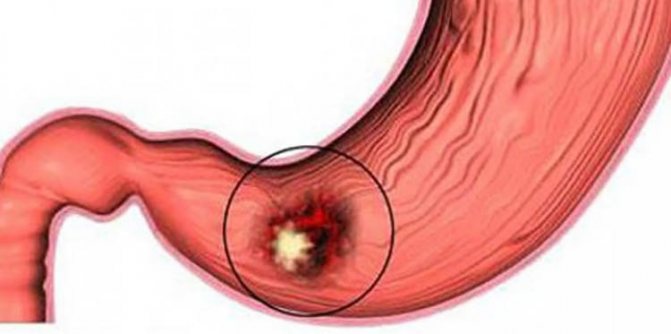

- treatment of periodontal disease, stomatitis;
- healing wounds, abscesses, lichens and acne treatment;
- reduction of pain in joint diseases;
- treatment of hypertension, atherosclerosis, rheumatism, malaria;


- a decrease in the frequency of epileptic seizures;
- withdrawal for diseases of the bladder;
- improved vision;
- improved sleep, appetite;


- reducing the manifestation of allergies;
- impotence treatment.
Possible problems
As mentioned above, a prominent sedum is an unpretentious, frost-resistant and drought-resistant plant; problems with its cultivation usually do not arise.
However, sometimes gardeners may be faced with the fact that the leaves of stonecrop begin to wrinkle. This happens when there is not enough moisture.Lack of light will manifest itself in leaf fall. And an excessive amount of fertilizers will cause the growth of bushes and the loss of the decorative properties of stonecrop.
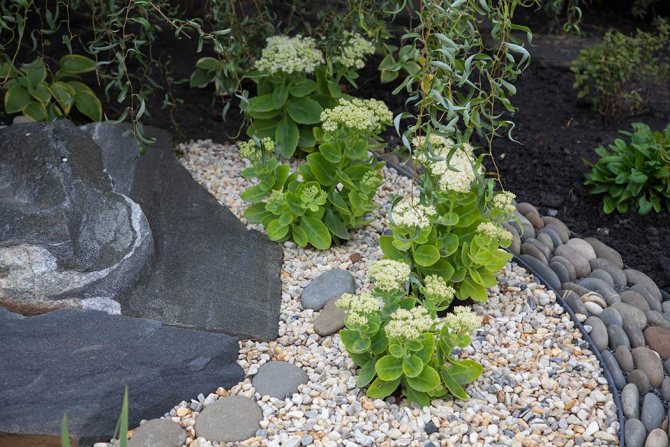

Wintering features
It tolerates low temperatures well. But young shrubs, as well as stonecrop of the Aureum variety, should be covered for the winter. A layer of fallen leaves is enough... It is removed in the spring.
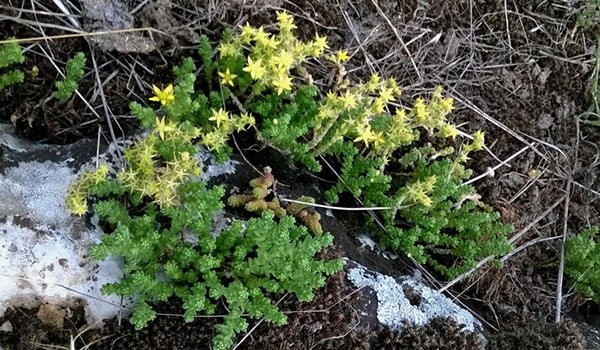

Mature specimens feel great even under the snowwithout losing its attractiveness. In warm snowy winters, sedum can suffer from excess moisture.
Note! This plant is one of the melliferous plants. The bees are very fond of its sweet, fragrant flowers. Even in dry season, a lot of nectar is released.
Sedum prominent in landscape design
Due to its beauty and unpretentiousness, stonecrop is widely used in landscape design. Accustomed to stony and arid soils, the prominent sedum can be planted in a rock garden, where it will look great against the background of the Alpine hills. Various varieties are planted for edging curbs. The sedum can be placed in a rockery, planting it in small stone vessels and woodwork. Also, this type is often used when decorating flower beds.
The sedum plant looks great next to red plants that have white, blue and silver leaves.
What is used
Healing tinctures can be prepared from various parts of stonecrop.
Flowers
When creating medicines, a young plant flower is often used. It has hemostatic and analgesic properties. The flowers contain alkaloids and acids that can strengthen nerve fibers. Therefore, it is possible to prepare medicinal tinctures from them to calm the nervous system. In addition, these decoctions improve blood circulation, help lower blood pressure and relieve headaches.
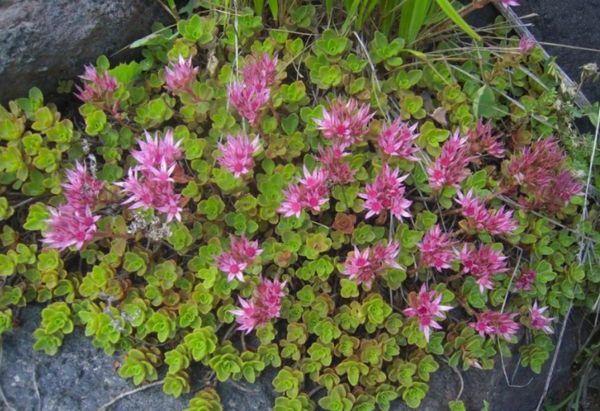

Leaves
If a person is faced with respiratory diseases or colds, decoctions of green leaves are used. They contain a lot of vitamin C, which strengthens the immune system and prevents the further development of colds. Also, the leaves contain trace elements that help to cough up phlegm and relieve inflammation in the nasopharynx.
Some experts advise using the leaves to improve the functioning of the digestive tract.
Application
Sedum great medicinal properties Medicinal use
Collection and processing of medicinal raw materials
Freshly harvested herb serves as a medicinal raw material.
It is harvested only in dry weather, in the morning hours, when the dew melts, cutting off the entire aerial part of the plant. It is forbidden to uproot stonecrop.
Use on the day of collection.
Application in official and traditional medicine
Sedum is a biogenic stimulant, enhances metabolic processes in tissues and their regeneration, has a general tonic and anti-inflammatory effect.
It is used for sluggish and poorly healing wounds, after severe injuries and massive blood loss, as well as for chronic inflammation of the sinuses. A good result is observed with periodontal disease.
To prepare the juice, the raw materials are washed well, scalded with boiling water, passed through a meat grinder and wrung out. The finished juice is diluted with water in a ratio of 1: 1 and boiled for 1 - 3 minutes. Take 1 teaspoon 3 times a day with meals.
When used externally, wipes are moistened with it and applied to the affected skin. Gums are massaged with juice in the morning and in the evening.
In inflammatory diseases of the female genital area, it helps to accelerate reparative processes.
It is used for chronic ischemic heart disease with frequent attacks of pain, pulmonary and heart failure, gastric ulcer and duodenal ulcer and chronic liver and gallbladder diseases. Stonecrop juice promotes bone fusion.
The medical industry produces an aqueous extract of the stonecrop herb called biosed.
Active composition of the herb
Sedum caustic contains a large number of compounds from a number of alkaloids. Among them, alkaloids were found, which have a stimulating, hemostatic, analgesic effect. However, they are highly toxic, and therefore an overdose of the herb can lead to serious damage to the central nervous system, respiratory arrest and cardiac arrest. The plant contains other biologically active components.
- Tannins. They have anti-inflammatory, astringent, wound-healing effects. Eliminate pathogens on damaged skin or mucous membranes.
- Glycosides. They have a cardiotonic, capillary-expanding effect. Show stimulating, bronchodilator, diuretic properties.
- Organic acids. They normalize hematopoiesis, improve intestinal motility, stimulate the secretory function of the digestive glands. They normalize the permeability of the vascular walls, have antibacterial, anti-inflammatory, immunomodulatory properties.
- Mucus. They improve the discharge of bronchial secretions, have enveloping, anti-inflammatory properties.
- Flavonoids. They have a mild diuretic and choleretic effect. They help to strengthen the vascular walls, normalize the biochemical composition of the blood. Show antioxidant effect.
- Saponins. Promote accelerated regeneration of epithelial tissue. Improves the functioning of the respiratory system. Show a mild irritating effect on the intestinal mucosa, improving its peristalsis.
- Coumarins. They are famous for their antitumor activity. They stimulate the process of recognition of atypical structures by immune cells, preventing the formation of metastases.
- Vitamin C. The main antioxidant of the human body, a stimulator of metabolic processes.
- Wax. Possesses bactericidal, astringent, healing properties.

